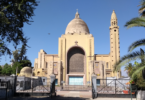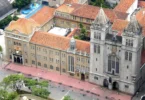Introduction

The Basilica of Bois-Chenu, otherwise called Bois Chênu or Sainte-Jeanne-d’Arc de Domrémy-la-Pucelle, is a huge and noteworthy church committed to Joan of Circular segment. This great basilica was built in the nineteenth 100 years and is arranged on a picturesque, forested slope in Domrémy-la-Pucelle, the town where Joan of Curve was conceived and spent her initial years. The basilica was worked to respect the tradition of the celebrated French champion, who assumed a significant part in the Hundred Years’ Conflict and turned into an image of mental fortitude, confidence, and positive energy. The decision of area, settled among the trees of the district’s normal scene, highlights the profound association between Joan of Curve and the provincial climate of her origination.
The design of the basilica is outstanding for its magnificence and authentic style, which mirrors the period in which it was built. It serves as a position of love as well as a journey site for the individuals who wish to give recognition to Joan of Bend, praising her life and the persevering through effect of her story. The structure’s development was essential for a more extensive development during the nineteenth 100 years to perceive and remember public legends and figures of extraordinary verifiable significance, exemplifying a deep satisfaction and otherworldly veneration.

The development of the Basilica of Bois-Chenu, devoted to Joan of Bend, started with the laying of the main stone on November 3, 1881. This site was picked for its huge association with Joan’s life, for all intents and purposes close to where she, a youthful shepherdess, is accepted to have heard the heavenly voices that would direct her fate. The underlying plan of the basilica was made by the engineer Paul Sédille, who sadly died in 1900 preceding the fruition of the undertaking. After his demise, his replacement, Georges Demay, and in this manner his children, Émile and René Demay, planners situated in Neufchâteau, kept directing the work, finishing the development in 1926. The first designs for the basilica imagined a more modest construction, and it was at first devoted to Holy person Michael, as Joan of Bend had not yet been exalted around then. Regardless of the continuous development, the principal mass was commended in the basilica in 1896. By 1897, a chime tower had been added, and four ringers were introduced, adding to the structure’s developing presence in the district.
A huge achievement happened in 1909 when Pope Pius X exalted Joan of Bend, denoting the most vital move toward her canonization. Nonetheless, it was only after 1920 that Pope Benedict XV formally sanctified her as a holy person. In 1922, Pope Pius XI pronounced Joan of Circular segment the optional supporter holy person of France, and a couple of years after the fact, in 1926, the basilica was officially sanctified in her name. The congregation was raised to the situation with a minor basilica on June 4, 1939, an acknowledgment that further featured its strict and verifiable significance. On July 24, 2006, the basilica was assigned a verifiable landmark by a pronouncement endorsed by the provincial consul, Pierre-René Lemas. This order was an affirmation of the structure’s social and building importance. The whole basilica was in this way ordered by a pronouncement on May 28, 2013, solidifying its status as a significant milestone.
The basilica’s ringer tower holds an extra qualification: it fills in as a geodesic important matter 4 inside the NTF (Public Cross over Mercator) framework, as per the French Public Foundation of Geographic and Woods Data (IGN). This novel component underlines the basilica’s job as a strict site, however as a fundamental piece of the locale’s topographical and social scene.

Architect: Paul Sédille
Architectural Style: Romanesque Revival architecture
The Basilica of Bois-Chenu is prestigious for its remarkable design and imaginative highlights, especially its striking polychrome exterior. This exceptional outside is made out of exchanging pink rock obtained from the Vosges district and the unadulterated white Euville stone from the Meuse, making a delightful difference that characterizes the basilica’s appearance. The basilica remains as a noticeable milestone, enlightened each night and regulating the Meuse Valley with a demeanor of greatness. The structure is planned in a neo-Romanesque style, described by its powerful and amicable structures. Its inside and outside are enhanced with gigantic mosaics that add to its loftiness. Moreover, the basilica highlights eight wonderful artworks by the craftsman Lionel Royer, which portray huge minutes from the existence of Joan of Circular segment, further advancing the site with authentic and creative importance.
An exceptional region inside the basilica is the grave, committed to Our Woman of the Armed forces. It houses the respected sculpture of Our Woman of Bermont, a significant relic associated with Joan of Curve herself. This sculpture is said to have been the one Joan supplicated before, making it a profoundly private and emblematic component of her inheritance. The forecourt of the basilica is likewise home to an assortment of prominent sculptures that honor Joan of Bend and her story. One such sculpture is of Joan offering herself to God for the satisfaction of her heavenly mission. This figure, made by Couteau, was skilled to the basilica in 1946 by the public authority of the Canadian region of Quebec. Another critical sculpture is “Joan and Her Voices,” etched by André-Joseph Allar in 1894, which depicts Joan’s otherworldly encounters. Furthermore, the forecourt highlights cast iron sculptures of Joan’s folks, Jacques d’Arc and Isabelle Romée, made in 1911, offering a sign of Joan’s unassuming roots and the family that impacted her initial life.
Inside the sepulcher, guests can likewise find two strong compositions by Alphonse Monchablon, both focused on the subject of penance during the Franco-Prussian Conflict of 1870. These works of art, one zeroing in on the military and the other on the naval force, add to the sepulcher’s serious environment and mirror the more extensive authentic setting of penance and gallantry related with Joan of Curve. This mix of craftsmanship, engineering, and history makes the Basilica of Bois-Chenu a significant demonstration of the getting through tradition of Joan of Circular segment.
The Bells of the Basilica
The Basilica of Bois-Chenu is renowned for its impressive set of bells, which play a significant role in enhancing the sacred atmosphere of the site. The current collection includes five peal bells, each contributing to the rich auditory heritage of this historic church. The story of the basilica’s bells began in 1897 when four peal bells were installed. These bells, crafted by the esteemed bellfounder Farnier de Robécourt, weighed a total of 3,440 kilograms. They were added to the new basilica as part of its initial construction, contributing to its grandeur and resonant sound that could be heard throughout the village of Domrémy-la-Pucelle and the surrounding region.
In 1926, an additional bell was added to the collection. This fifth bell was gifted in honor of the priestly diamond wedding anniversary of Monsignor Foucault, the Bishop of Saint-Dié. The bell was a special tribute and symbolized the importance of the occasion. The daughters of Georges Farnier, the donor of the bell, served as its godmothers, further connecting the bell to the legacy of the Farnier family and their ties to the basilica’s history.Together, these five bells form an integral part of the basilica’s cultural and religious heritage, ringing out to mark significant moments, celebrate liturgical events, and maintain a sense of tradition and continuity for the community.
Organ
The Basilica of Bois-Chenu is home to a distinguished pipe organ that enhances the spiritual atmosphere of the church with its powerful and resonant sound. This remarkable instrument was built by the renowned Jacquot-Lavergne company, based in Rambervillers, between 1942 and 1944. The construction period of the organ was notably during World War II, a testament to the dedication and craftsmanship of the builders in a time of great uncertainty. The organ features two manuals (keyboards) and a pedal board, allowing for a wide range of musical expression and versatility. Its design incorporates traditional organ-building techniques that produce a rich and full sound, complementing the basilica’s acoustics and enhancing liturgical ceremonies, musical performances, and special events held within the church.
The instrument was inaugurated on April 10, 1944, by the esteemed organist and composer André Marchal. His performance on this special occasion marked the completion of the organ’s construction and celebrated its entry into the church’s musical life. André Marchal, known for his deep understanding and interpretation of organ music, was the ideal figure to launch this significant addition to the basilica. The organ remains a central feature of the basilica’s musical tradition, contributing to its historic and cultural identity while enriching the spiritual experience of all who visit.
Feast Day
Feast day : 30 May
The Basilica of Bois-Chenu in Domrémy-la-Pucelle, France, does not have a specific feast day dedicated to it as a church building. However, it is associated with Joan of Arc, whose feast day in the Catholic Church is May 30th. This day is celebrated to honor her canonization as a saint, which took place in 1920. Joan of Arc’s feast day is an occasion that draws attention to the basilica, as it is closely linked to her life and legacy.
Church Mass Timing
Yet to Update
Church Opening Time:
Monday : 9:00 am – 5:00 pm
Tuesday : 9:00 am – 5:00 pm
Wednesday : 9:00 am – 5:00 pm
Thursday : 9:00 am – 5:00 pm
Friday : 9:00 am – 5:00 pm
Saturday : 9:00 am – 5:00 pm
Sunday : 9:00 am – 5:00 pm
Contact Info
Address :
88630 Domrémy-la-Pucelle, France.
Phone : + 0329069180
Accommodations
Connectivities
Airway
The Nearest Airport to The Church of Basilica of Bois-Chenu, Domrémy-la-Pucelle, France, is, Aéropôle Grand Nancy Tomblaine, 5 Av. Nelson Mandela, 54510 Tomblaine, France, which is just 55 min (63.4 km) via D674. away from the basilica.
Railway
The Nearest Railway to The Church of Basilica of Bois-Chenu, Domrémy-la-Pucelle, France, is, Neufchâteau 88300, France, which is 11 min (10.0 km) via D164. away from the basilica.








